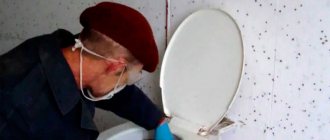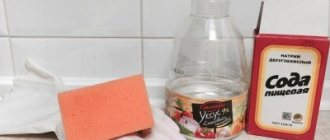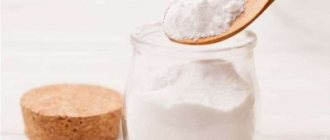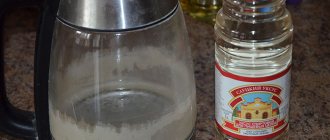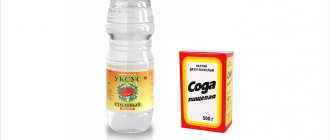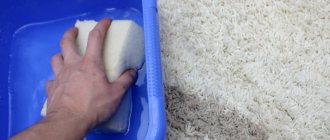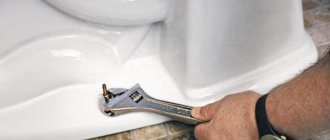Maintaining cleanliness in the toilet room is an important issue, since the health of the family may depend on it. If you think about the well-being of your loved ones, want to protect them from germs, and at the same time not overdo it with chemicals, use the proven folk method of cleaning the toilet with soda and vinegar.
The toilet room is one of the most visited places in the apartment, where the toilet is used for its intended purpose every day. Any housewife wants to keep her home clean and tidy, especially in those places where the accumulation of germs is maximum. The most dangerous thing in the house in terms of bacteria content is the earthenware toilet. Billions of microbes accumulate under its rim, settle on the walls of the ceramic and penetrate into hard-to-reach places. When flushed, microbes can scatter 1.5-2 meters. If the toilet and bathroom are combined, then disinfection is necessary not only for the plumbing, but also for toothbrushes, tile grouts and shower stalls.
Causes of urinary stones and limescale
If dirt and deposits appear in the toilet, take immediate action to avoid unpleasant odors and sediment buildup.
The following types of pollution are formed inside the toilet:
- Urine stone is the result of laziness and carelessness of the owners. Most often, yellow, inconspicuous stains form on the plumbing fixtures of people who forget to flush after themselves. Initially, drops of urine dry out and form a thin hymen. With repeated failure to rinse, a more durable film is formed - urinary stone. You can only get rid of it using special methods, but it is better to prevent its occurrence by carrying out prevention.
Limescale – minerals contained in water (well or river, tap water). The more often you wash off, the more actively a film forms. You need to get rid of limescale regularly, because over time it clogs the holes supplying water to the toilet, which leads to complete failure of the plumbing.
Enameled plumbing is less prone to the formation of plaque that cannot be removed, but on rough surfaces it appears more often and more intensely.
Cleaning the toilet surface with baking soda and vinegar
What if the “faience friend” is decorated with a yellow coating and emits an unpleasant odor? Grandmother’s remedies will help clean the toilet:
Pour half a glass of baking soda into the toilet and add vinegar to this powder. Apply the mixture evenly to all surfaces. Depending on the degree of contamination, wait from 10 to 30 minutes, then remove the plaque using a brush. Mix the remaining part of NaHCO3 with warm water until a paste forms and treat external surfaces with this mass, rinse with water. Take a glass of acetic acid using a brush and rub it on the tank and other external and internal parts of the toilet. After 20-30 minutes, wet the brush, sprinkle it with a handful of baking soda, then use it to clean the treated areas. Repeat the procedure until your “faience friend” gets rid of dirt and plaque
Pay special attention to the rim - the most dirt accumulates under it.
Both methods are excellent for bleaching and removing mold, dirt deposits and unpleasant odors. The only drawback of the second method is that it is suitable for cleaning only for those housewives who are willing to put up with the pungent odor of acetic acid.
Watch the video: the blogger deliberately clogs the toilet pipe, and then tests traditional methods to clear the blockage.
We'll tell you how to clean a washing machine with soda and vinegar below.
Sanox
- Check that the drain is working properly. Water should not flow constantly.
- Purchase and hang a toilet cleaner.
- After relieving yourself, lightly clean the walls of the toilet with a brush.
- Don't throw food down the toilet.
- Carry out timely cleaning.
In order to clean the toilet drain pipe of plaque, you will need vinegar, about a glass and old rags. It is advisable to heat the vinegar, although you can use a solution at room temperature. Then, after putting on gloves, we generously soak old rags with heated vinegar and place them on the affected areas of the drain. The toilet is closed with a lid and left for a while. The plaque softens under the influence of vinegar and is easily separated from the surface with a spatula or knife.
How to tidy up your toilet cistern
Over time, plaque accumulates on the walls of the tank and deposits form, which affects not only the drainage system, but also the condition of the toilet itself. Thus, rust is fraught with the appearance of yellow stripes in places where water drains, and lime deposits on the bottom impair the tightness of the valve, as a result of which the tank may leak barely noticeably.
To gain access to the inside of the tank, you must remove the lid. How to do it?
- In older float-type models with a side lever, the cover is not secured and can be easily removed by lifting it up.
- In models with a vertical rod (the handle that you pull to drain the water), you should first pull the rod up, unscrew the handle from the thread, and then remove the lid.
- Modern toilets with a push-button flush system are not much more complicated - to dismantle the lid, you need to remove the button along with the rim. This is done like this: press the drain button and, holding it in this state, wrap the rim ring counterclockwise several times; Then you can release the button and freely unscrew the part.
Now it's time to start sanitary and hygienic procedures. The same products that are used to treat the toilet will help eliminate the problem inside the tank: acid-based gels, vinegar, oxalic acid, Coca-Cola, pipe cleaning fluids (see recipes above).
- Method 1. Drain the water from the tank. Pour a bottle of cleaning gel (Sanox, Sanfor, Adrilan) into the bottom of the tank, wait until the tank is filled with water, and leave for 8-10 hours.
- Method 2. Apply a cleaning agent (liquid, acid powder, gel, vinegar with soda) with a sponge to the walls, bottom, parts of the drainage system and wait the required time, then rinse with warm water, drain, and refill the tank.
Korean invention Pongtu
The methods listed above are successful, but there is a risk that something will go wrong and some of the collected water will overflow from the reservoir onto the floor. Pongtu is an invention from South Korea that eliminates this risk. Simply wipe the headband with a dry cloth and attach a special layer to it. Release the water, which will cause the material to bulge. Now you just need to press the bulge a few times and the plug will go away.
Chemistry guards purity
You can clean non-critical dirt with improvised substances. When limescale deposits look more like the coating of a toilet bowl, and the formation of urinary stones has acquired a dark brown tint, folk remedies are useless. Only heavy artillery in the form of potent chemical cleaners can cope here.
Orthophosphoric acid. This product will help not only clean off the mineral deposits on the bottom of the toilet, but also get rid of the rust that covers the parts of the drain and fill fittings inside the tank. To clean, you need to pour about 100-150 g of the drug into the bowl and into the toilet cistern, wait 10-15 minutes and thoroughly rinse the surface of the product with running water. The main advantage of this product is that it does not destroy rubber and plastic products.
Hydrochloric acid
It must be used with extreme caution, protecting not only the skin, but also the respiratory tract. It is enough to wipe the limescale with the substance, and it will immediately dissolve
And to remove urinary stones, you need to pour ½ cup into the bowl and leave it for 10 minutes. When using, make sure that no plastic or rubber connections were installed when connecting the toilet. Hydrochloric acid will dissolve them along with the plaque.
Chlorine. Used in whitening and dissolves all organic compounds. Chlorine vapors are dangerous to the body, so this cleaning method is extremely undesirable. Also, after using chlorine, rubber seals lose their elasticity and begin to leak water.
Abrasive preparations. The use of powders when cleaning sanitary ware is quite effective. But small granules can leave microscopic scratches on the surface of the toilet, disrupting the smoothness of the finish of the product, which will subsequently lead to even greater deposition of lime and urinary stone.
It is best to use specialized detergents that are intended only for toilets. Be sure to read the product label before use.
In case of critical and extremely abundant growth of mineral deposits, you can use a liquid electrolyte, which is used in car batteries. It can only be used as a last resort when other means have failed. It contains sulfuric acid, so be sure to take care of your own safety.
The toilet is clogged, what should I do?
A plunger is usually used in cases where the blockage is still passable and the water flows out of the toilet, albeit slowly.
If the water from the toilet begins to drain slowly, it means that there is a blockage in the drainage system. Before calling a plumber, you should try to deal with it on your own - in most cases it works.
Before the advent of modern means, the toilet was cleaned with a plunger, pushing the blockage further into the sewer pipe, but now another method is popular: with the help of acid, its cause is softened or dissolved and itself goes into the pipe with a stream of water (of course, if we are not talking about an object that accidentally fell to stock).
- Scoop the water out of the drain so that just a little remains, and pour half a pack of soda into its hole. Use a plunger to push the baking soda as far as possible and pour in a glass of vinegar. The reaction takes 20 minutes; After this time, rinse the toilet drain with boiling water (1.5-2 l).
- Use a special tool for cleaning sewer pipes - “Mole”, “TiretTurbo”, “Deboucher”, “Mr. Muscle”, etc. Alternatively, for small blockages, you can pour a two-liter bottle of Coca-Cola into the drain hole.
When should you call a plumber?
If the above methods for clearing the blockage did not help, or you are not ready to fix the problem yourself, call a professional. They have the necessary devices, specialized cables, with the help of which medium and severe blockages will be eliminated without your participation. There are often cases when disassembling the system is required. This should also be entrusted to specialists. They will eliminate installation errors, improve the connection of parts, and correctly install the rubber gasket.
If the difficulty in draining water is caused by overflowing of the sewer pit and the pipe remaining in the sewage for a long time, professional sewer cleaning using equipment will be required. Finally, you may be faced with the need to completely replace your sewer system. This will happen if the pipes are worn out or incorrectly positioned. We need a comprehensive diagnosis of the state of the system, which will be carried out by specialists using the necessary instruments.
Blockages can be local or general. The first ones operate within the confines of your apartment, and here you can easily act independently. But the general ones are inherent in the central sewer system, and you can’t handle it yourself. It is not difficult to distinguish one from the other. If water slowly drains from all your plumbing fixtures, it means the common riser is clogged - call a plumber. If most drains are fine, try cleaning the drain yourself.
Clearing a clogged toilet with baking soda and vinegar
The cause of this problem can be anything: from various household garbage to the accumulation of food debris washed down the drain. If your toilet is clogged and the water stops flowing, try using a mixture of baking soda and vinegar:
- Pour 1/2 pack of regular baking soda (NaHCO3) into the drain hole;
- Pour in 2 cups of acetic acid;
- If possible, it is better to plug the drain with a large rag or towel to prevent the evaporation of the gas released during the reaction.
This method will help eliminate small “traffic jams”. The main thing is not to increase the dosage; if necessary, it is better to repeat the procedure again.
Soda ash (Na2CO3) will also be a good help in getting rid of blockages. With its help, you will get rid of heavy dirt, while simultaneously cleaning the inside of the toilet. For this:
- In a deep metal container, mix 5 tbsp. l. baking soda and soda ash. Pour the mixture into the drain. You can also apply it to internal surfaces using a rag or sponge.
- Wait 30-40 minutes. Take two spray bottles, fill one with regular bleach like “White”, and the other with acetic acid. Spray the vinegar solution down the drain and along the walls, then pour bleach over everything.
- Close the toilet lid and leave the room. After 30-40 minutes. rinse it with plenty of water and ventilate thoroughly.
Work with such a mixture can only be carried out with rubber gloves and a respirator - its components are poisonous and can cause burns to the mucous membrane.
If the drain is completely clogged, caustic soda (NaOH or caustic soda) will come to the rescue. The cleaning algorithm will depend on the form of release of caustic soda.
If NaOH is present in crystalline form:
- Pour 4 kg of caustic soda into an iron bucket with a volume of 10-12 liters, stir until it is completely dissolved. As you stir, the water will become warm. Don't be surprised - the temperature rise is due to a rapid chemical reaction.
- Carefully pour the solution into the drain and wait about an hour. Rinse with plenty of water. It is better to fill the entire solution - it is not recommended to store it, as over time it loses its properties.
If you have NaOH in a liquid state at home, cleaning with it is done as follows:
- Shake the closed container with the gel;
- Pour 200 to 250 ml into the drain. substances, leave for 2-4 hours;
- Rinse off with plenty of warm water.
These products will help you quickly break through the blockage and completely clear the drain. When using any type of soda to clean the toilet, remember that all work should be carried out only with rubber gloves.
You can also clean the bathtub with soda and vinegar; read about this method here.
Some nuances
However, there are factors that must be taken into account when cleaning pipes:
- This may be hazardous to your health. This means caustic soda. Therefore, be sure to follow safety precautions, including gloves and a mask.
- Heavy contamination can take a long time to remove. Very often about 10 hours, sometimes the procedure needs to be repeated several times.
- Before adding soda, make sure that the pipes are strong enough for the procedure, and that the material from which they are made will not deteriorate under the influence of a chemical reaction.
- If you cleaned the pipes with purchased products, then it is prohibited to use sodium bicarbonate and vinegar. This may lead to unexpected reactions. It is better to wait a day so that the store-bought substance has time to wash off.
Methods for cleaning the toilet at home using folk remedies
To avoid the doubts gnawing at us, let’s remember our grandmother’s recipes, long forgotten by us. These little tricks will help you get the much-needed desired result.
How to clean a toilet with baking soda
To clean your toilet from limescale to a sparkling shine, think about regular baking soda. So, we clean like our grandmothers with baking soda. This recipe will tell you how to clean a toilet at home with soda and vinegar. The main thing is to do everything according to the instructions!
Before the scheduled cleaning, we do the following:
- sprinkle the inner surface of the toilet generously with baking soda, let it sit for half an hour;
- then pour in vinegar;
- While everything is foaming and seething, we carefully work with a brush.
The result of the effect will amaze you: no rust, no limescale, no urinary stone, just perfect shine.
How to clean a toilet with mustard powder
Here is another, long-forgotten recipe for how to clean a toilet using folk remedies. Probably every housewife has an unopened pack of mustard powder in her house. Yes, with its help you can clean the toilet until it shines by preparing a product from mustard, vinegar and ordinary starch, which is undoubtedly found in every home.
The recipe is as follows:
- take 1 tablespoon of mustard powder;
- add 1 tablespoon of citric acid there;
- add 1/2 of a pack of starch;
- Mix everything thoroughly with the addition of plain water.
The toilet bowl cleaner is ready, let's start cleaning. Apply to the surface of the toilet and leave for a while, then wash off with a brush. The effect is guaranteed to be excellent and without much effort.
Cleaning the toilet with vinegar
Let's think about ordinary vinegar. It will also give an excellent and effective result, effortlessly rid the toilet of urinary stones inside.
Recipe and method of use:
- take a glass of nine percent vinegar and heat it to forty degrees;
- add a small pinch of salt to the heated vinegar;
- mix all this until the salt is completely dissolved and pour it onto the walls of the toilet;
- leave overnight for better results;
- In the morning, wash off with running water from the tank.
Everything is perfect, easy and simple - the toilet is cleaned to a shine.
Cleaning the toilet with wood ash
Let us also recall a folk recipe for cleaning a toilet using wood ash. So, a couple of packs of citric acid and wood will make your toilet smile and shine with an amazing shine.
Recipe and method of use:
- take ordinary wood ash (it will give the effect of abundant foam, which will facilitate further cleaning);
- mix the ash with citric acid (all in equal quantities and proportions);
- At night we put it in a toilet glass, and in the morning we clean everything with a brush, easily and effortlessly.
This composition will help get rid of unwanted contaminants.
A lot can be remembered and applied in practice, but it is better, of course, not to forget that daily cleaning with such an ordinary brush and a little ordinary toilet bowl cleaner will give you the opportunity not to think about the difficulties of cleaning unwanted stains. All the work done during the process will keep your toilet in perfect condition and save nerves, effort and time.
And now we invite you to watch a video about how to wash a toilet correctly, as well as about the rules for caring for it:
Recipe 3
Vinegar and baking soda do not have to be used together for drain cleaning.
For example, this recipe involves using only baking soda. Another component is also taken - salt. Ordinary table salt has good effectiveness against various types of contaminants, and therefore it can also be used to solve the painful problem of clogged household drains. The recipe is as simple as possible - you need to take half a glass of salt and soda and pour them into the pipe. This can be done one by one, or by first mixing both components in one glass. Next, immediately pour in hot water, about two to three liters. It is advisable to do this overnight, as you will need to leave everything as is for at least eight hours. Be sure to make sure that nothing, not even clean water, is poured into the pipe for the entire time that the soda and salt are in effect.
There is also a separate effective method that answers the question of how to clear a clog if it has formed in the sink. The method is also based on the use of vinegar and soda, which once again demonstrates the effectiveness of these substances.
Here's what to do:
First thoroughly clean the sink. It is necessary to remove all accessible contaminants and then wipe the surface dry; take half a glass of baking soda and pour it down the drain
It is important to ensure that all the substance gets inside. If soda lingers on the surface of the sink, force it back in using any suitable available tools, for example, a regular cotton swab; then pour a similar amount of vinegar into the drain hole; there is no need to close anything, as in the case of cleaning pipes - after a few minutes you can pour hot boiled water down the drain; the final stage is washing with plenty of running water. You can open either a cold or a hot tap - there is not much difference
You need to rinse until the water begins to flow into the hole as expected, that is, without any delays
You can open either a cold or a hot tap - there is not much difference. You need to rinse until the water begins to flow into the hole as expected, that is, without any delays.
Now you know how to clean pipes with soda and vinegar. As you can see, there is nothing complicated here. Almost all effective methods are based on the need to fall asleep and pour substances into the pipe or sink drain
Even though vinegar and baking soda are considered mild chemicals, some caution must be exercised when working with them. Be careful not to get them in your eyes. Try not to breathe in the substance formed as a result of a chemical reaction between baking soda and vinegar - it is not entirely safe
It is also recommended to wear gloves
Try not to breathe in the substance formed as a result of the chemical reaction between soda and vinegar - it is not entirely safe. It is also recommended to wear gloves.
It is always much easier, cheaper and faster to prevent a problem than to fix it later. The blockages can be very dense and large, and in such cases the help of improvised means, which include soda and vinegar, may be limited. Therefore, there is a possibility that you will have to go to the store and buy expensive household chemicals. And all because you didn’t clean the sewer in time. It is highly recommended to resort to this activity at least once every few months. Simply add baking soda or vinegar to your drains, fill them with hot water, and enjoy functional, trouble-free household drainage for many years to come.
We scrub the toilet with special household chemicals.
Modern chemicals clean enameled plumbing fixtures from limescale, sediment, urinary stone, blackness and rust. To clean your bathroom, purchase the product in the household chemicals department or online, read the instructions for use and process according to safety precautions: wear rubber protective gloves and a respiratory mask to protect your respiratory tract.
Cleaning with Coca-Cola
It is easy to clean the bottom and thicket of the toilet bowl from urinary stones with Coca-Cola.
Its components effectively corrode contaminants caught in the long-term contact zone. Therefore, many housewives buy this inexpensive drink for cleaning kettles and plumbing:
- Remove water by pushing it down the drain with sharp movements.
- Pour 1.5–2 liters. Coca-Cola into the toilet.
- After a couple of hours, wipe off the dissolved dirt with a toilet brush.
Given the liquid consistency of the drink, removing intense stains under the rim is almost impossible. Therefore, housewives use Coca-Cola as a preventive measure against urinary stones and limescale.
"Whiteness"
It’s easy to clean a toilet from streaks with “Beliznaya”, since chlorine resists many types of stains and stubborn dirt.
The disadvantage of this product is the unpleasant odor, but it is inexpensive, so it is used by many housewives.
Using “Whiteness” to clean the toilet step by step:
Remove as much water as possible from the toilet. Pour “Whiteness” onto a brush or contaminated enamel
To enhance the effect, add any product with a thick consistency for cleaning the toilet. Scrub the toilet bowl vigorously, paying special attention to problem areas. After 2-3 hours, clean with a brush and remove any remaining deposits with a non-metallic scraper.
Hydrochloric acid
When using this product, be sure to follow safety rules so as not to damage your skin and lungs! Pour hydrochloric acid over the toilet bowl, scrub with a brush and close the lid. After 15–20 minutes, scrub the stains again and rinse off the acid. Do not use the product if the drain is made of plastic pipes.
Automotive electrolyte
Electrolyte for cars helps against stone, corrosion and plaque, returning the bathroom to its original whiteness and shine.
Additionally, the product will clear the sewer from blockages and eliminate red rusty streams. The processing principle is the same as that of hydrochloric acid, but use this method as little as possible so as not to damage the enamel.
Basic cleaning methods determine the source
It will be possible to choose the most effective way to combat pollution of this kind only after it is possible to establish the reasons for its occurrence, chemical composition, and so on.
Limescale
Limescale deposits in the toilet bowl are formed due to the accumulation of mineral compounds under the rim, which are found in very large quantities in tap water.
In some cases, leaks occur in places where water drains. They are yellow or orange in color. The activity of their occurrence directly depends on how often the water is washed off there.
If you leave deposits on the nozzles through which water enters the tank, they will become clogged over time, which, in turn, will lead to an increase in the time it takes to fill the tank.
Urine stone
Urine stone is also a plaque similar to calcareous deposits, but it has a completely different nature. It is a mineral substance that is excreted from the human body along with urine. The stone is painted in a dirty yellow color, in some cases it can have a gray color. If a ceramic product has certain irregularities on the inside, then the stone will form there.
To prevent the stone from starting to form in the toilet bowl, even at the time of purchase you should check how smooth the surface inside this ceramic product is. It is best to give preference to sanitary porcelain. Its cost is slightly higher compared to earthenware, but its structure is more dense - this can be achieved largely due to the fairly high temperature at which this product is fired. This material has excellent performance characteristics:
- due to its density, it will not accumulate limescale;
- smooth texture does not give yellowness from urinary stones;
- Such a surface will be much easier to clean and wash even with improvised means.
The key reason for the appearance of various deposits is the lack of preventive cleaning. When the product takes on a neglected appearance, the question of how to clean the toilet from rust and other deposits is much more difficult to solve. If you wash it regularly, it will retain its original appearance for a long time.
How to restore whiteness and freshness to a toilet bowl
The main problems that owners of “faience products” face are yellowness, smudges and deposits:
- urinary stone;
- limescale;
- and accumulations of rust.
If the previous owners left the plumbing in a disrepair, then you will have to work hard to eliminate the complex of problems, otherwise it is better to replace everything right away.
Although sediments differ in their chemical composition, they are equally susceptible to the same oxidizing agents.
Household chemicals
Thanks to modern cleaning products, keeping your bathroom clean will not be difficult.
Special products for treating plumbing products include aggressive acids: hydrochloric, oxalic, orthophosphoric, sulfamic, etc., which dissolve urinary and limestone, remove rust and plaque.
In case of minor deposits, it is enough to fill the places where they accumulate with toilet gel (CillitBang, Sanox, Sanfor, Adrilan, Comet for toilets, Toilet duck, etc.) and wait the required amount of time, indicated on the packaging. Usually this is 10-30 minutes, but in case of severe contamination it can be left for 8-12 hours, for example, left until the morning.
How to properly clean a toilet? Video instruction:
Homemade folk remedies
Acetic or citric acid are also effective in combating urinary stones, lime deposits and red stains.
- Heat 9% vinegar to a temperature of 40 °C, add baking soda at the rate of 2 tsp. per glass of liquid and mix thoroughly. Apply the resulting mixture generously to problem areas and leave for 8-10 hours - it is better to do the procedure before bed.
- Citric acid is used in its pure form. Pour the contents of several sachets (the quantity depends on the scale of the problem) over the deposits so that the powder covers them, and after 2 hours, rinse the toilet with hot water.
White
Sodium hypochlorite is a strong oxidizing agent; it destroys urinary stone and limescale, simultaneously eliminating yellowness and traces of rust on the toilet. Pour the contents of one bottle overnight into the outlet neck (drain area), and distribute the remainder over the inner surface of the toilet. In the morning, rinse off the product with warm water.
With old and abundant deposits of urinary stones, the above remedies may be powerless. In this case, you will have to repeat the cleaning procedure several times or use more powerful chemicals.
Oxalic acid
Sold in its pure form in hardware stores
The product is poisonous and requires special precautions: use it only with gloves, and cover your face with a medical mask or a damp cloth so as not to accidentally inhale it.
Apply oxalic acid powder over the growths of urinary stone and lime, leave for 1-2 hours. After the time has passed, rinse with warm water.
Special household chemicals
You can buy a professional pipe cleaner in supermarkets - it is very effective against salts and limescale.
Coca Cola
Coca-Cola's mild acidity makes it an excellent cleanser.
Oddly enough, the potency of cola is comparable to a professional product - it is no coincidence that experienced plumbers recommend it for cleaning pipes and drains. Pour 4 liters of drink into the toilet, after removing the water from the drain. Leave it overnight, drain the water in the morning and clean the inner walls with a brush.
Recommendations for preventing blockages
If the entry of foreign objects into the sewer most often comes as a surprise, then the appearance of blockages from siltation can be prevented 100%. If we summarize all the measures that can be taken to prevent blockages, the list will look like this:
- It is necessary to monitor the compliance of the sewerage system with the design parameters. If “wet” points (plumbing fixtures or kitchen sinks) are moved from the outlet of the sewer riser, special sanitary pumps designed specifically for such drains should be used.
- The sewer system is not designed to dispose of waste. Large objects can clog it. Personal hygiene products, rags, cleaning products and other food debris are not allowed to enter the drain. It is better to throw leftover food in a bucket rather than in the sink. Modern sinks are often equipped with built-in waste disposal units. It is very comfortable.
- When repairing and cleaning sewers, you should use professional products and tools. For example, polyethylene pipes can only be cleaned with soft synthetic brushes that will not scratch their inner surface. Any scratches, chips, transitions of complex geometry can become “thresholds” even for small debris. The clog can begin to grow like a crystal - from one grain stuck to the pipe.
- To avoid silting with fats, preventive maintenance should be carried out regularly. In principle, if you do this often, then simply pouring boiling water over the system is enough. Some experts say that, in theory, water that is too hot can burn through plastic pipes. But in practice, such experience has not been recorded. There are specialized products on sale that are designed to remove fatty deposits on pipes. They can be used as needed.
- There is a theory that says you shouldn't be obsessive about scrubbing your plates before washing them. It is believed that small insoluble food residues, like brushes, will knock off the grease settling on the walls, thereby cleaning the pipes.
According to expert statistics, the most common cause of blockages is the “human factor.” These are randomly discarded large items. If the sewerage system is operated carefully, but still constantly gets clogged, there are most likely problems in the structure itself. You need to look at the construction diagrams and change the levels of nodes. In this case, it is even safer to install a sanitary pump. The device costs about 10 thousand rubles, but it is purchased once and solves the problem of blockages forever.
The proposed folk methods for getting rid of blockages in the riser and water supply will help you avoid major problems and financial costs associated with replacing the entire sewer system.
Why does plaque form?
To understand how to clean a toilet at home, you need to determine what type of contamination is most important in your case. There are few difficult-to-remove contaminants, usually they are the following.
- Urine stone. It consists of complex mineral salts that fall onto the surface of the toilet bowl and under the rim with urine. Often the problem appears in families where household members forget to flush the toilet or the toilet itself is rarely subjected to preventive treatment. If a urinary stone has already formed, it is difficult to get rid of it; conventional means do not cope well with it.
- Limescale. In homes with high water hardness, the calcium salts it contains eventually settle in the tank and on the walls of the toilet. Various other types of contaminants quickly accumulate on top of the limescale. To whiten the toilet, in this case, acid-based products are used.
- Rust. The appearance of rusty streaks is also associated with water quality. This could be old, rusty water pipes or water with a high iron content from a well.
Mechanical damage to earthenware contributes to the accumulation of dirt. There is no need to wash the surface of the toilet bowl and cistern with metal brushes or coarse abrasive materials. Also, you should not pour hot water into the toilet - this will cause microcracks to form on the surface.
To improve water quality, various filters are used or preventive agents are constantly added to the toilet cistern in the form of special blisters and tablets.
Drastic measures
If the clog cannot be removed using available methods, all that remains is to disassemble the toilet.
In such a situation, it is strongly recommended to call a plumber, since it is quite difficult to carefully remove the toilet and maintain its functionality:
- In Soviet times, the toilet was fixed with cement, so dismantling requires a specialized tool.
- The pipe leading to the toilet can also be embedded in the wall.
- If you disassemble it yourself, you can additionally clog the sewer pipe with construction waste.
